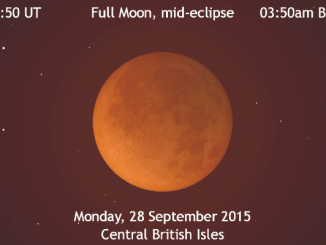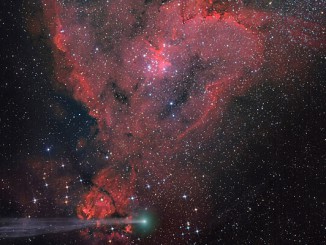
Month: September 2015


Don’t miss the totally eclipsed ‘supermoon’ of 28 September
While you probably don’t relish the prospect of waking up in the small hours of most Monday mornings, you will want to set your alarm for 2am BST on Monday, 28 September for this month’s showstopper celestial event — a rare total lunar eclipse of an unusually large ‘supermoon’ visible in its entirety (weather permitting) from the British Isles!

Astronomers identify a new class of medium-sized black holes
Nearly all black holes come in one of two sizes: stellar mass black holes that weigh up to a few dozen times the mass of our Sun, or supermassive black holes ranging from a million to several billion times the Sun’s mass. A team led by astronomers at the University of Maryland and NASA’s Goddard Space Flight Center has found evidence for a new intermediate-mass black hole about 5,000 times the mass of our star.



“The Arrow Missed the Heart” by Lefteris Velissaratos
A stunning juxtaposition of an ethereal solar system body, long-period comet C/2014 E2 Jacques, and the vast, heart-shaped emission nebula IC 1805, some 7,500 light-years away in the constellation Cassiopeia — winning image of the Planets, Comets & Asteroids category in the Insight Astronomy Photographer of the Year competition 2015.

Mysterious energy bursts provide new way to chart the cosmos in 3-D
In deep space, some unknown astrophysical phenomenon is causing mysterious bursts of energy that appear as short flashes of radio waves. In a University of British Columbia study, researchers propose a new way to calculate cosmological distances using these fast radio bursts. The method allows researchers to position distant galaxies in three dimensions and map out the cosmos.

Hubble observes galaxies’ evolution in slow motion
It is known today that merging galaxies play a large role in their evolution, and the formation of elliptical galaxies in particular. However, there are only a few merging systems close enough to be observed in depth. The pair of interacting galaxies seen here — known as NGC 3921 — is one of these systems. But ‘close’ is a relative term: NGC 3921 lies 270 million light-years away.

Historic Brashear telescope saved for restoration in NZ Dark Sky Reserve
A 125-year-old, 18-inch (46-cm) aperture Brashear refracting telescope with an illustrious history that has languished in storage for half a century has found a new Antipodean home. It marks the first step on the road to restoring the 7-ton, 8-metre-long instrument to its former glory, destined to become the centrepiece of a public outreach Astronomy Centre near the shore of Lake Tekapo in the heart of New Zealand’s South Island.

Geoptik SLR hotshoe Synta finderscope adapter
Reviewer Steve Ringwood acknowledges that some stunning astrophotography is possible by use of a camera and its terrestrial lens alone. But in dim nocturnal light, it can be difficult to accurately aim the camera at a particular target in the sky. The Geoptik SLR hotshoe finderscope adapter is a convenient mediator between a DSLR camera and a Synta-style red dot or optical finder’s dovetail for precise pointing.
